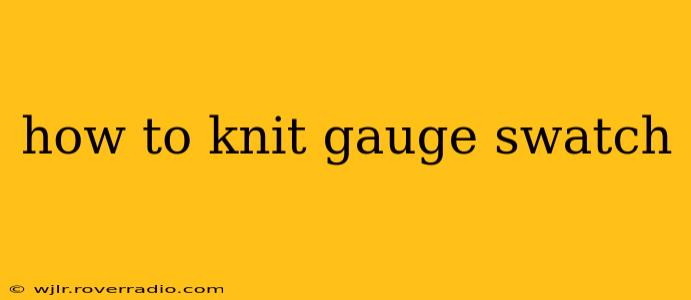Knitting a gauge swatch might seem like an extra step, but it's the cornerstone of successful knitting projects. Failing to knit a gauge swatch can lead to sweaters that are too small, shawls that are too short, or blankets that never quite reach the intended size. This comprehensive guide will walk you through the process, answering all your burning questions and ensuring your next project is perfectly sized.
Why is Knitting a Gauge Swatch Important?
Before we dive into the how-to, let's understand the why. Yarn is inconsistent. Even within the same dye lot, the thickness and twist can vary slightly. Your tension (how tightly or loosely you knit) also plays a huge role. A gauge swatch allows you to:
- Determine your personal tension: Everyone knits differently. Your gauge swatch reveals your unique knitting tension, ensuring your finished project matches the pattern's intended dimensions.
- Verify yarn suitability: A gauge swatch helps ensure your chosen yarn is appropriate for the pattern. If your gauge is significantly different from the pattern's recommended gauge, you might need to select a different yarn or adjust your needle size.
- Avoid costly mistakes: The time spent knitting a small swatch is significantly less than the time spent unraveling a large, incorrectly sized project.
What Supplies Do I Need to Knit a Gauge Swatch?
You'll need just a few simple things:
- Your chosen yarn: Use the same yarn you plan to use for your main project.
- Your chosen needles: Use the same needle size recommended in the pattern.
- Scissors: To cut the yarn.
- A ruler or tape measure: To measure your swatch accurately.
- A needle (optional): To weave in the ends.
How Big Should My Gauge Swatch Be?
Generally, a gauge swatch should be at least 4 inches by 4 inches (10cm x 10cm). This provides a large enough sample to accurately determine your gauge. Larger swatches are even better, especially for textured stitches that might distort the gauge reading in smaller areas. Some patterns recommend larger swatches (6 inches or more). Always check your pattern instructions for specific size recommendations.
How to Knit a Gauge Swatch: A Step-by-Step Guide
-
Cast on: Cast on a number of stitches that will create a square at least 4 inches wide when worked in your chosen stitch pattern. Many patterns suggest a specific number of stitches to cast on; otherwise, cast on a multiple of the stitch pattern repeat plus a few extra stitches for edging.
-
Work the pattern: Knit the swatch in the stitch pattern specified in the pattern instructions. Work the swatch to a height of at least 4 inches.
-
Bind off: Bind off loosely. Avoid binding off too tightly, as this can distort the gauge.
-
Wash and block: Washing and blocking your swatch is crucial for accurate gauge measurement, especially if you are working with a fiber that is prone to significant change in size when wet. Follow the instructions on your yarn label for washing and blocking. (Blocking is the process of making the piece flat, using water or steam to relax the fibers.)
-
Measure your gauge: Once the swatch is completely dry, gently lay it flat. Using your ruler or tape measure, count the number of stitches and rows in a 4-inch square. Record your results and compare them to the pattern's recommended gauge.
What if My Gauge is Off?
If your gauge is off, you have a few options:
- Try a different needle size: If your gauge is too small, try knitting another swatch with larger needles. If your gauge is too large, try smaller needles.
- Try a different yarn: Sometimes, the yarn itself is the issue, and selecting a yarn more closely aligned with the pattern’s gauge will solve the problem.
- Adjust your tension: Practice knitting and paying close attention to the tightness of your stitches. This will be a more time-consuming option, but if you plan to repeatedly use a certain yarn, this is something to work on.
How Many Gauge Swatches Should I Knit?
Generally, one well-executed swatch is sufficient. However, if you're trying different needle sizes or yarns, you may need to knit multiple swatches.
How Long Should I Wait Before Measuring My Gauge Swatch?
Always measure your gauge swatch after it has been washed and completely dried. Waiting until the swatch is completely dry ensures that the fibers have relaxed to their true size, giving you the most accurate gauge reading.
This comprehensive guide should equip you with all the knowledge you need to conquer the gauge swatch. Happy knitting!
